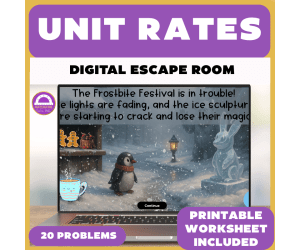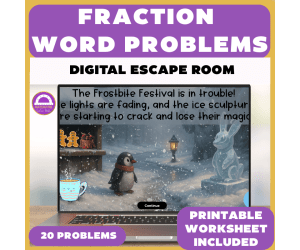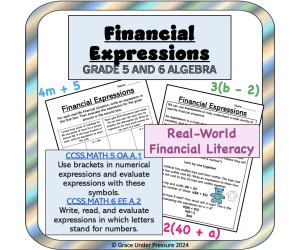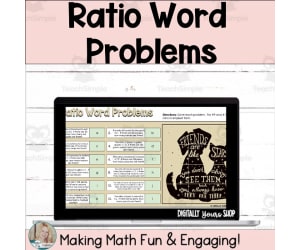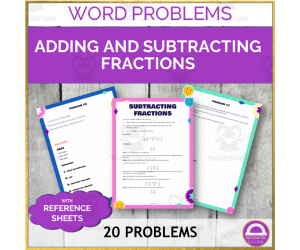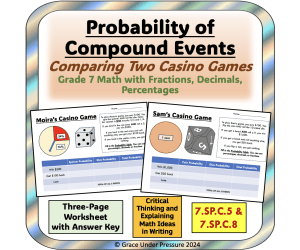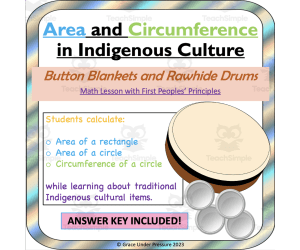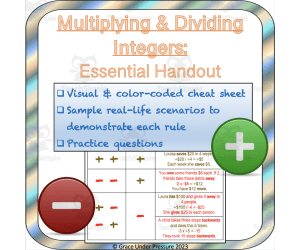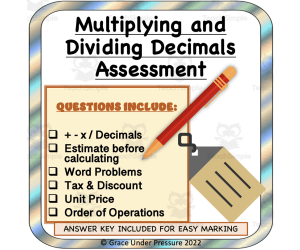2,737 products added recently
7th Grade Word Problems
Challenge seventh graders with word problems covering advanced topics like linear equations and inequalities. These exercises develop critical analysis. Use them to deepen comprehension and prepare students for high school math.
Scale Drawing Word Problems Digital and Printable
Math, Geometry, Measurements, Grade 7, 8, 9, Activities, Worksheets & Printables, Task Cards, Word Problems
Engage your learners with this Scale Drawing Word Problems Activity: Digital and Printable, and drive the stress out of teaching and learning! Be it digital or paper-and-pencil classrooms, this resource will work in engaging your students, saving your preparation time, and offering them effective self-paced learning. This activity is both instructive and engaging, with 20 real-world problems involving scale drawings, area, and perimeter. With the self-checking features, students get immediate feedback and are free to work at their own pace, coming to you only when they need help. Why You Will Love This Resource ✅ No Prep Required Spend less time planning! Everything you need is ready to go, whether you're teaching online or in person. ✅ Digital and Printable Options Digital versions for online learners that are interactive. Printable worksheets and task cards for hands-on practice. ✅ Self-Checking Tools for Independent Learning Students receive immediate feedback, which builds confidence and limits disruptions. Great for stations, homework, or independent study. ✅ Engaging and Fun Real-world problems keep students engaged. Focused on practical challenges to be solved with scale drawings, measurements, and geometric concepts. What's Included? ???? 20 Word Problems Practice making scale drawings using imperial and customary measurements. Find area and perimeter of rectangles and triangles. Printable Worksheets & Task Cards Great for classroom activities, group work, or homework assignments. ✔️ Complete Solutions Clear, detailed answers for easy reference by students and teachers. Perfect for Your Classroom Grade Levels: Ideal for grade levels learning about scale drawings and the basics of geometry. Flexible Use: Great for digital, hybrid, or traditional learning environments Independent Learning: Self-paced design promotes student accountability while minimizing disruptions. Why Teachers Love It This resource is designed to make teaching easier and learning more effective. The no-prep format saves you time, while the self-checking features keep students on track. With both digital and printable options, you can tailor the activity to fit your unique teaching needs.
Author Matemaths
Tags Pixel Art, Interactive Activity, Digital Learning, Matemaths, Task Cards, Printable, Digital, Word Problems, Scale Drawing
Winter Unit Rates Word Problems Digital Escape Room
Math, Fractions, Winter, Seasons, Holiday & Seasonal, Grade 5, 6, 7, Escape Room, Activities, Worksheets & Printables, Word Problems, Worksheets
If your students struggle with unit rates, this Winter Digital Escape Room will give them the practice they need without the struggle. Rather than slog through another page of word problems, students are placed into a scenario where unit rate problems are a necessary part of bringing back the Frostbite Festival. This allows enough purpose to be added to avoid taking away from the math. Students work through twenty actual-unit-rate word problems set in four escape room winter scenes: The Snack Shack, Skating Trail, Yeti Workshop, and Penguin Performance. Students work with word problems related to cost, distance, time, and quantity from the everyday experience they realize from using unit rates. In order to progress, students must compute the correct answer and type it into the escape room. The escape room is a completely self-contained activity, which means students will not be able to progress with an incorrect answer, making this activity perfect for independent practice. One of the most beneficial aspects of this resource is the low level of work that it generates. There is no prep work that is necessary. You don’t have to set up anything, including logins and passwords and lock screens. You can just send out the link via Google Classroom, Canvas, Schoology, Microsoft Teams, or whatever tool that you are using. They just click and start. This autosave functionality comes in very handy during longer class times or interruptions. So long as students have had the chance to log back into the same computer and browser, they will pick up exactly where they left off. To make it more flexible, a printable version is also included. You will get a worksheet featuring all twenty unit rate problems, a matching version task card set, and finally, a full answer key. This is perfect for math center activities, small-scale intervention groups, or homework. Both the student and teacher instructions are provided and WrittenClearly, so there’s no misunderstanding or guestimation of how to do things. Students know just how to input their answers, and teachers know how to assign and use the autosave function. The skills which will be developed here include the understanding of the interpretation of unit rates, calculating a unit rate from a ratio, and using the rate in practical applications of money, time, distance, and measure problems. A winter unit rate resource that is engaging, organized, and actually easy to implement is not easy to find, but this escape room resource certainly delivers all of these things. Such a resource keeps students on task and provides a reliable no-prep resource for you to implement repeatedly.
Author Matemaths
Rating
Tags Mtemaths, Winter, Word Problems, Task Cards, Worksheet, Digital, Printable, Unit Rates, Escape Room
Fraction Word Problems Digital Escape Room
Math, Fractions, Winter, Seasons, Holiday & Seasonal, Grade 5, 6, 7, Escape Room, Activities, Worksheets & Printables, Word Problems, Worksheets
Fraction problems on paper usually go over like a, well, snowball with your students; but this Winter Digital Escape Room changes that right away! Instead of plowing through problems on a page, students find themselves right in the middle of a wintery story in which their math smarts make all the difference. Their task? Unfreeze the Frostbite Festival with fraction problems embedded in four story scenarios. Students solve twenty fraction problems involving adding, subtracting, multiplying, and dividing fractions. With each correct solution giving the student a further piece of the puzzle and therefore the incentive to take their time and think before responding, this activity strongly encourages the student to take their time and think before responding. This activity also helps the student work independently without the need for constant checks by the teacher since the activity is entirely self-checking. The advantage: flexibility to perform calculations as improper fractions or as mixed numbers. This eliminates unnecessary frustration and “but my answer is right too” arguments among students. Then there is the autosave feature that allows students to save their work midway through the lesson, as long as they are on the same computer or accessing the page on the same web browser. There are also four winter-themed scenarios to keep things new and interesting throughout. Students will move around different activity cards of Snack Shack, Skating Trail, Yeti Workshop, and Penguin Performance. It is completely engaging and provides meaning without being distracting, which is exactly what you need when you are in the review session. This resource is the real deal in the realm of ‘no prep’ products. There is no account that needs to be set up, no passwords, and no complex installation. You simply share the link from Google Classroom, Canvas, Schoology, or whatever platform you use, and the kids can start working. It is completely seamless from the perspective of the users, including chromebooks, laptops, desktops, and tablets. In instances when you would prefer paper options or if you desire to reuse the problems in another manner, a complete printable version is also included. You'll get a worksheet with all the problems, a set of task cards to match the problems, and an answer key. Clear directions for both teachers and students are provided, and all can see exactly what the activity entails. Topics covered for both math and reading consist of all four fraction operations with unlike denominators and real-world fraction word problems. If you are searching for a winter fractions review that is engaging, organized, and easy to facilitate, this digital escape room meets every requirement and your students will want to solve it.
Author Matemaths
Rating
Tags Mtemaths, Fractions, Winter, Word Problems, Task Cards, Worksheet, Digital, Printable
6th Grade Math: Expressions and Equations Bundle: 7 Activities
Math, Graphing, Multiplication and Division, Division, Numbers, Algebra, Money, Grade 5, 6, 7, Worksheets & Printables, Word Problems, Activities
Do you need some new ideas for your 6th grade math unit to meet the Common Core State Standards for Expressions and Equations? Here is a ready-to-go bundle with seven fun real-life activities to incorporate into your unit plan. 1) Exponent Board Game: Students won't even notice how many exponent math problems they actually solve while racing their friends around this game board. 2) 5 Stations for Early Algebra: These fun stations allow students to solve word problems, play an expression game, create a growing pattern with counters, solve one-step equations, graph a pattern, and more! 3) Equivalent Expressions: Real-Life Financial Situations: Students write simple expressions for real-life situations, then use one of four strategies (from the provided handout) to convert them to equivalent expressions. A matching activity is also included! 4) Modelling Equations Using Visual Balance Scales: Here's a fun visual activity to teach your students about doing the same thing to each side of an equation! 5) The Wave Pool Problem: Students have to create tables of values, figure out an expression, graph two options, and decide which way they would prefer to pay to visit a new wave pool in their neighbourhood. 6) Inequality Matching Game: Here's a fun, whole-class matching game to practice solving simple inequalities! 7) Hockey Math Equations: Students complete tables and graph independent and dependent variables while exploring all the math found at a hockey arena. Grades to Use With: This bundle is designed for students in Grade 6, but can be used for Grade 5 enrichment, Grade 7 or 8 review, or high school special education classes. What's Included: 32 Page PDF with 7 Activities and complete answer keys! If you like this product, check out my other 6th Grade Math Bundles for each learning strand: 6th Grade Math Statistics and Probability Bundle 6th Grade Math Ratio and Proportional Relationships Bundle 6th Grade Math Number System Bundle 6th Grade Math: Geometry
Author Grace Under Pressure
Tags 6th Grade Math, Grade 6 Math, Algebra, Financial Literacy, Inequalities, Equations, Equivalent Expressions, Tables And Graphs, Expressions, Variables
Math Journal: Experimental Probability with Two Independent Events
ELA, Math, Percentages, Fractions, Statistics, Writing, Grade 5, 6, 7, 8, 9, Worksheets & Printables, Word Problems, Activities
Math Journal: Experimental Probability with Two Independent Events This resource serves as a helpful teaching tool for educators focusing on the concepts of experimental probability and theoretical probability of two independent events in middle school mathematics. It offers an engaging math journal entry exercise that allows students to explain their mathematical thinking in pictures, numbers, diagrams, and words. How to Use: Students are given the following question: You have a six-sided die and a penny. If you roll the die twice and flip the penny twice, which is more likely: to get two sixes on the die or two heads from the penny? Explain your thinking using pictures, numbers, and words. Can you figure out the percentage chance of each event happening? Give students dice, coins, and mini whiteboards to work with so they can start to test out their ideas and theories. Encourage students to tackle the penny first as there are fewer results when flipping two coins. Suggest that students work together in pairs or small groups and use a table or chart to record the experimental options that could occur. You may want to start by teaching a mini-lesson about the probability of two independent events: that one multiplies the probability of each event to determine the probability of BOTH events. Grades to Use With This resource is ideal for use with students in grades 5-9 but can also be used as special education material or enrichment content for gifted children aged between grades 4-6. Finally, it could be used in a high school special education classroom. What's Included: This two page PDF is ready to print and go! If you enjoy this math journal entry, check out my bundle of 20 Middle School Math Journal Entries or my Math Journal Rubric for easy marking. Or, explore other probability items in my store.
Author Grace Under Pressure
Tags Math Journal, Experimental Probability, Two Independent Events, Middle School, Probability, Dice , Coins, Chance, Middle School Math, Fractions
Money Math Life Skills Worksheet: Reading Restaurant Menus Level 3
Special Resources, Creative Arts, Art, Life Studies, Social Emotional Learning (SEL), Special Education Needs (SEN), Life Skills, Math, Money, Grade 7, 8, 9, Worksheets & Printables, Word Problems, Activities, Worksheets
Money Math Life Skills Worksheet : Reading Restaurant Menus Level 3 This 192-question Special Education life skills activity teaches grade 7-9 students to calculate tips, apply sales tax, and determine total meal costs using six standard restaurant breakfast and lunch menus. Students will: - Calculate meal costs with 2, 3, and 4 menu items - Apply sales tax to meal costs - Calculate tips Use this printable worksheet one-on-one or in special education classes to develop essential real-world math and money management abilities. It includes step-by-step instructions, questions, answers, graphics, and ideas for implementation. Excellent for IEP goal setting and measuring progress in money math. Engage students with this highly interactive life skills activity!
Author Adulting Life Skills Resources
Tags Life Skills Money Math, Special Education Money Math, Independent Living Skills, IEP Goal-Oriented Skills, Community-Based Instruction, Adulting On The Spectrum, Social And Emotional Learning, Life Skills For Adults, Life Skills For Teens, Autism And Money Skills
Algebra Word Problems: Writing & Evaluating Financial Expressions
Math, Algebra, Grade 5, 6, 7, Worksheets & Printables, Word Problems
Help show your middle grades students in grades 5-7 how the algebra skills they are learning in the classroom can be helpful in real life! This math lesson incorporates financial literacy by using realistic scenarios for word problems that all involve money. By using a mix of simple financial literacy situations (earning money by doing chores or work, purchasing in bulk, signing up for a swimming club), your students will get the opportunity to write expressions for word problems (including brackets). Then, they will evaluate each expression based on an amount provided. This activity will make these math skills more salient and useful as your students will see how math can be helpful in everyday life! How to Use: Print a 3-page handout for each student. Go over the first page the includes important algebra definitions and a sample word problem so your students understand the concepts On the two-page worksheet there are seven scenarios where students must determine an expression for a simple financial situation. They write the expression in one box. Then, they evaluate the expression for a given value in the second box. They could work on this independently or in pairs or small groups: you choose what's best for your students. There is also room for early finishers to create their own word problem to trade with a friend. What's Included: 5-Page PDF: Ready to Print and Use! Title Page/Teacher Instructions Student Handout with Definitions and Sample Problem 2-Page Student Worksheet Answer Key If you enjoy this algebra lesson, check out others in my store: Early Algebra Math Stations: Patterns, Expressions, Tables, Graphing Equivalent Expressions: Matching and Financial Situations Early Algebra Input Output Math Game Early Algebra Real World Word Problem: The Wave Pool with Expressions, Tables, and Graphs Writing and Solving Two Step Equations from Real-Life Situations
Author Grace Under Pressure
Tags Evaluating Expressions, Writing Expressions, Algebra, 5th Grade Algebra, 6th Grade Algebra, Word Problems, Algebra Word Problems, Expression Word Problems, Financial Literacy, Money Math
6th Grade Math: Statistics and Probability Bundle: 4 Activities
Math, Statistics, Graphing, Money, Common Core, Grade 5, 6, 7, Worksheets & Printables, Word Problems, Activities
Do you need some new ideas for your 6th grade math unit to meet the Common Core State Standards for Statistics and Probability? Here is a ready-to-go bundle with four fun real-life activities to incorporate into your unit plan. 1) Statistical Questions: Students are taught what a statistical question is: a question that has numerical answers that vary.. 8 questions are included. Students need to identify if they are statistical questions or not. If they are, students think of how the data might be collected. If they are not, students explain what aspects of a statistical question are missing. Finally, students write 4 questions of their own (one should not be a statistical question) and they trade with a friend to see if they can identify the odd one out. 2) Dot Plots and Histograms: Students will collect numerical data through a survey and create their own dot plots and histograms to display their findings! This gives them a sense of ownership over their learning, and it is a great way to assess their skills! Discussion questions and self- assessment are included. 3) Math Stations: Statistics and Probability: Station 3 in particular has students create a dot plot and calculate the mean, median and mode of provided data. They can also do the probability stations if you want to address those skills. 4) Mean, Median and Interquartile Range of Hourly Wages: From a cashier to a taxi driver to an account to a CEO, students are given 10 realistic hourly wages. First, they create a histogram to display the data. Next, they write the wages in order from smallest to largest. They use this information to calculate the mean, the median, and the interquartile range. After that, they eliminate the outlier (the CEO wage) and recalculate the same statistics. Discussion questions are included. Grades to Use With: This bundle is designed for students in Grade 6, but can be used for Grade 5 enrichment, Grade 7 or 8 review, or high school special education classes. What's Included: 20 Page PDF with 4 Activities
Author Grace Under Pressure
Tags 6th Grade Math, Statistics , Probability, Dot Plots, Histograms, Mean, Median, Interquartile Range, Statistical Questions, Financial Literacy
Ratio Word Problems Digital Self-Checking Activity
Math, Algebra, Grade 6, 7, Worksheets & Printables, Word Problems, Activities
Introduction to Ratio Word Problems Digital Self-Checking Activity Ratio Word Problems Digital Self-Checking Activity is an ingenious teaching tool designed to make math lessons a fun-filled experience. This digital resource provides a practical, hands-on approach for educators aiming to clarify the concept of working with ratios while being easily accessible for public school teachers and homeschoolers alike. Suitable Grade Levels and Utility This resource fits perfectly in the curriculum of Grade 6 and Grade 7, particularly focusing on Algebra. While it excellently handles word problems related to ratios, this activity can also be molded for an array of other mathematical concepts. Description of the Activity The learning experience gets amplified with this engaging activity featuring a 12-question challenge. As students correctly solve each question on Google Sheets, a hidden image cleverly reveals itself bit by bit, creating an interactive sense of progress. Moreover, color-coded answers add another layer of interactivity: correct responses turn bright green, while incorrect ones appear red. Tailor-made for Different Settings: Implement it during morning tasks or homework; Utilize as bell-ringer tasks or exit tickets; Use it during warm-ups or review sessions—flexibility being its key highlight! Paperless Consistency: The promise is kept simple and adaptive—it requires no time-consuming prep from your end but can be assigned instantly via Google Classroom after adding it to your Google Drive! A Mix of Procedural Knowledge and Conceptual Understanding: The objective here isn't merely about understanding procedures but gaining complete command over conceptual clarity—methodical tools get seamlessly married with fundamental comprehension in this activity. Inclusions Inside: A pack of twelve Ratio Word Problems waits on Google Sheets! There's also a Student Recording Sheet attached to keep track of progress and a Teacher Answer Key to streamline the correction process. The Bottom Line: In conclusion, Ratio Word Problems Digital Self Checking Activity is an undeniably enriching educational asset for all educators advocating holistic learning!
Author Digitally Yours Shop
Tags Ratio Word Problems, Digital Activity, Self-checking, Math Education, Hands-on Learning
6th Grade Math: Geometry Bundle: 5 Activities: Area, Perimeter, Volume
Math, Number Lines, Decimals, Multiplication and Division, Multiplication, Fractions, Graphing, Division, Numbers, Grade 5, 6, 7, Worksheets & Printables, Word Problems, Activities
Do you need some new ideas for your 6th grade math unit to meet the Common Core State Standards for Geometry? Here is a ready-to-go bundle with five fun real-life activities to incorporate into your unit plan. 1) Area of Triangles, Parallelograms, and Trapezoids: This JIGSAW activity allows your students to become experts at determining the area of one kind of shape. Then, using the Jigsaw instructional strategy, groups of three experts teach each other all of the formulas. 2) 5 Stations for Area, Perimeter, and Volume of Right-Angle Shapes: These fun stations allow students to plan a backyard, solve word problems, measure a box, and work with compound shapes! 3) Design a Logo: Students use their knowledge of plotting ordered pairs to draw several polygons on a Cartesian plane to reveal a logo. Then they get to design their own and trade their coordinates with a friend! 4) Paint a Doghouse: Students use organized tables and grid paper to carefully calculate the surface area of a doghouse to determine how much paint they would need to spruce it up. A great real world application! 5) I have included another bonus inquiry activity : Students investigate the relationship between area and perimeter to see if they can find a predictable trend. Grades to Use With: This bundle is designed for students in Grade 6, but can be used for Grade 5 enrichment, Grade 7 or 8 review, or high school special education classes. What's Included: 24 Page PDF with 5 Activities and complete answer keys! If you like this product, check out my other 6th Grade Math Bundles for each learning strand: 6th Grade Math Statistics and Probability Bundle 6th Grade Math Ratio and Proportional Relationships Bundle 6th Grade Math Number System Bundle My goal is always to show students how the math they learn in class is useful in their everyday lives!
Author Grace Under Pressure
Tags 6th Grade Math, Grade 6 Math, Geometry, Paralleogram, Trapezoid, Triangle, Surface Area, Area, Perimeter, Volume
Canada Day or 4th of July Math Word Problems: Budget, Rate, Factors
Life Studies, Home Economics, Math, Money, Multiplication and Division, Division, Decimals, Grade 4, 5, 6, 7, Worksheets & Printables, Word Problems, Worksheets
Canada Day or 4th of July Math Word Problems: Budget, Rate, Factors, Multiples, Financial Literacy, Decimal Operations Here are three challenging, multi-step word problems for your middle school or intermediate students in grades 4-7. Each problem requires students to use their knowledge of factors and multiples, unit prices, and decimal operations. This is a great way to incorporate some simple financial literacy and budgeting into your math program. Two versions are provided: 4th of July and Canada Day: each version has a ready-to-print 3 page worksheet! Questions Included: Students need to figure out how to buy ingredients for 80 hamburgers at the best price. They will need to determine ways to make 80 using packs of 8, 12, 20, and 25. They will need to calculate the better unit prices. They think of ways a teacher could spend $20 to get some treats for her class with 24 students. There are inexpensive items like lollypops and pricier options like pop-its. Students should choose two different combinations of items. Finally, they determine how much a town would need to spend on fireworks and flags for their celebration. COMPLETE ANSWER KEY INCLUDED Grades to Use With: These activities could be used in grades 4-7 or in high school special education classrooms. In grades 4 and 5, you might do one problem together as a class, and then allow students to work in small groups to solve the other two. In grade 6 and 7, students should be able to complete these in a more independent way. If you enjoy this seasonal math activity , check out others in my store: Grocery Game: Winter Holidays Grocery Game: Spring Edition Halloween Budget Back To School Budget Christmas or Winter Holidays Budget Gingerbread Math: Fractions, Decimals, Percent Valentine's Day Shopping Lucky Leprechauns Multiplication Math Game
Author Grace Under Pressure
Tags 4th Of July, July 4th, Canada Day, Problem Solving, Word Problems, Financial Literacy, Budget, Decimals, Factors, Multiples
Multi Step Word Problems | Adding and Subtracting Fractions
Math, Fractions, Grade 5, 6, 7, Word Problems, Worksheets & Printables
This comprehensive no-prep tool is designed to make the complexities of working with fractions easy for your students. To make your teaching and your students' learning easy, this resource comes complete with a two-page reference sheet that serves as a quick review on adding and subtracting fractions. Whether your students need a refresher or an initial understanding, this reference sheet is a valuable help. Each problem in this set is carefully crafted to challenge and engage students, providing real-world scenarios that require the application of adding and subtracting fractions with unlike denominators. But what truly makes this resource more valuable is the inclusion of detailed, step-by-step solutions for every problem. This feature ensures that students not only tackle the problems but also understand the underlying concepts. No more confusion or uncertainty – this resource empowers your students to grasp these fundamental mathematical principles with confidence. This resource is a great addition to your teaching arsenal and can be used effectively in various scenarios, making it perfect for: Morning Work: Kickstart your students' day with engaging multistep word problems that foster critical thinking and mathematical skills. Homework: Reinforce learning outside the classroom by assigning these problems as homework, allowing students to practice and consolidate their knowledge. Small Groups or Large Group Instructions: Adapt the resource to your class size and teaching style, whether it's a collaborative small group activity or a whole-class instruction. Early Finishers: Keep your fast-paced learners challenged and occupied with these enriching problems that promote mathematical thinking. Emergency Sub Plan: Ensure uninterrupted learning even when you have a substitute teacher by having this resource ready to go. This resource empowers both teachers and students with the tools needed to learn these essential mathematical concepts. Make learning fractions an engaging and rewarding experience, and watch your students thrive in their mathematical journey.
Author Matemaths
Tags Matemaths, Worksheet, Fractions, Word Problems
Probability Word Problems Middle School Probability of Compound Events
Math, Statistics, Fractions, Decimals, Percentages, Grade 6, 7, 8, Worksheets & Printables, Word Problems, Worksheets
This middle school (grades 6-8) probability lesson and worksheet has three parts to help your class understand the probability of compound events (2 events that both occur but do not affect one another) and how to write probabilities as decimals and percentages. How it Works: There are two "casino games" presented. Each has two steps and specific rules. 1) Students first determine the theoretical probability (in fractions, decimals, or percents) of the casino game that has a spinner and a die and three different outcomes. 2) Students next determine the theoretical probability (in fractions, decimals or percents) of the casino game that has a penny and a die and three different outcomes. 3) Finally, students will compare the two games and pick which game they would choose to play using their math calculations as justification. Students can use fractions, decimals, or percents to figure out the theoretical probabilities from these two games. They will notice that all the outcomes in one game will always add to 1.00 or 100% This lesson is specifically created to target 7th Grade Statistics Learning Outcomes 7.SP.C.5 and 7.SP.C.8 What's Included: 5 Page PDF- Ready to Print and Use! - Teacher Instructions - 3-Page Student Worksheet with 2 Casino Games, Calculation Tables, and Written Reflection - COMPLETE ANSWER KEY INCLUDED If you like this activity, check out other probability options in my store! Middle School Math Stations or Centers for Statistics and Probability: Grades 5-8 These 5 math stations are a great way to help your students prepare for a unit test. They involve statistics and probability including working with dice, finding mode, median and mean, and creating simple graphs. Theoretical and Experimental Probability: Hands-On Math Task with Fractions and Percentages Here's a super low-prep probability experiment you can perform in your classroom, and easily tie into percentage math skills as well!
Author Grace Under Pressure
Tags Probability Word Problems, Probability Worksheet, Probability Of Compound Events, Probability, Compound Events, Middle School Probability, Fractions, Decimals
Circumference and Area of Circles (with First Peoples' Principles)
Social Studies, First Peoples (Native), Math, Geometry, Measurements, Grade 6, 7, 8, Worksheets & Printables, Word Problems, Worksheets
Circumference and Area of Circles with First Peoples' Principles is a teaching resource that combines math education with a basic introduction to two cultural traditions from indigenous groups. It is suitable for middle grades students in 6th to 8th grades. This lesson provides a practical application of geometry by instructing students on how to calculate the areas of rectangles as well as the area and circumference of circles. The lesson plan blends hands-on activities with relevant mathematics concepts, helping students to understand math theory through real-life tasks. 1) Students learn what a button blanket is and its cultural significance. They measure the area of a "blanket" and calculate the area of the "buttons." Then, they cut out the buttons and glue them on the blanket in a design. Finally, they calculate the area of the blanket that is not covered by the buttons. 2) Students learn what a drum is and its cultural significance. They calculate the circumference of the "drum." Then they determine the area and circumference of a piece of rawhide that would be needed to overhang and cover the drum. This flexible lesson can be used in whole-class sessions to guide every student step by step. It may also serve as a resource for small group work or homework assignments, promoting independent problem-solving skills outside school hours. Grades to Use With: This product is specifically designed to align with the British Columbia Mathematics 7 curriculum requirements, but it can fit into any learning environment studying circle areas & perimeters - ranging from middle school math classes, high school social studies lessons, or high school special education. The worksheets also help meet CCSSMP1 standards. What's included: An easy-to-follow four-page PDF including two student worksheets. An answer key for teachers to accurately assess student progress through each exercise. If you enjoy this math activity , check out many others in my store: Grace Under Pressure
Author Grace Under Pressure
Tags Circles, Geometry, Indigenous Culture, Area, Circumference, Radius, Diameter, Button Blanket, Drum, Area Of Circle
Percent Word Problems: Calculating Taxes, Tips, Sale Prices Worksheets
Special Resources, Life Studies, Life Skills, Math, Percentages, Decimals, Money, Fractions, Finance, Home Economics, Grade 6, 7, 8, 9, Worksheets & Printables, Word Problems, Worksheets
Percent Math Lesson: Calculating Taxes, Tips, and Sale Prices Here's a ready-to-go lesson for your middle school math unit on percentages. It encourages students to use multiple methods and mental math when calculating the tax, tip, or sale price for everyday transactions. This is one of the times you can easily say to your students, "You will use this math regularly in your life!" How to Use: Start with the handout, which goes through three simple methods for calculating percentages. Benchmark: An easy calculation strategy using familiar percentages like 1%, 10%, and 50%. Decimals: Calculating involves multiplying the amount by its matching decimal form percentage. Fractions: Division based on fraction equivalents is used for identifying certain percentage amounts. Tell your students that certain methods work best for certain situations. For example, the fraction method is great for 50% or 25% off. The benchmark method is easy when calculating a 10% tip. The decimal method works great for calculating 12% tax. Next, students have six real world math problems to tackle involving taxes, tips, and sale prices. They can use any of the strategies to solve any of the problems- they should choose the one that is the easiest to use for each scenario! Students can work individually or in pairs or small groups collaboratively. Grades to Use With: This lesson is perfect for grade 7 classes that are working on Proportional Relationships to solve multistep problems. It could also be used for enrichment in grade 6 or for a review and lesson about multiple strategies in grades 8 and 9. Finally, it could be used in high school special education classrooms. What's Included: Ready-to-print 5 Page PDF with a title page, handout, 2 pages of practice questions, and a complete answer key! If you like this percentage activity, check out others in my store: Math Stations: Percent, Decimals and Fractions Visual Math: Percentages, Decimals, Ratios and Fractions Posters Grocery Store Shopping: Price Comparisons
Author Grace Under Pressure
Tags Percent Calculations, Real-world Math, Percentages, Financial Literacy, Mental Math, Fractions, Decimals, Budget, Percent, Percent Word Problems
Math Practice Simplified L - Pre-Algebra
Math, Algebra, Grade 6, 7, 8, Worksheets & Printables, Word Problems, Worksheets
This mathematics-based resource is designed for grades 6-8. It’s imperative for students to have a strong foundation in basic math skills. This resource provides real-world activities to help students practice with signed numbers, expressions with exponents, square numbers and roots. Use this resource as a building block to higher mathematics. The first part of this resource focuses on integers. Rational and irrational numbers follow. This resource is perfect to prepare students to succeed on standardized tests . An answer key is included. Aligned to National Council of Teachers of Mathematics (NCTM) Standards.
Author Classroom Complete Press
Tags Math, Mathematics, Integers, Word Problems, Rational Numbers, Exponents, Square Root, Middle, Drills, Answer Key
Math Practice Simplified I - Money & Measurement
Math, Money, Measurements, Grade 5, 6, 7, 8, Worksheets & Printables, Word Problems, Worksheets
This mathematics-based resource is designed for grades 5-8. It’s imperative for students to have a strong foundation in basic math skills. This resource provides activities to help students understand everyday math basics through money and measurement. Students will add currency in the form of coins and determine how much change they will get back. Students will then move on to more advanced concepts, like budgeting, saving and borrowing money. This resource is perfect to prepare students to succeed on standardized tests . An answer key is included. Aligned to National Council of Teachers of Mathematics (NCTM) Standards.
Author Classroom Complete Press
Tags Math, Mathematics, Money, Measurement, Time, Temperature, Percentages, Decimals, Middle, Answer Key
Understanding Integers: Graphing Integers on a Number Line
Math, Number Lines, Early Math, Algebra, Grade 5, 6, 7, Worksheets & Printables, Word Problems, Worksheets
What is an integer? On what side of the number line will they be? This resource is perfect practice for students who are being introduced to integers. Students will know the difference between a negative number and positive number. Each worksheet contains a number line for visual aid and representation. Students are to graph each integer shown and by doing so, students will have more understanding of where the number is located on a number line. These integers may be in a set or individual. Students will also read real world examples of negative and positive numbers and decide where to graph each on a number line. Additional practice is included for students to tell the value of a letter shown on the number line. With the 5 different activities included in this set, it is a great introduction to integers and to set the foundation for future problems regarding integers. Includes: 5 practice pages answer key Check out the thumbnails to get an idea of what the pages will look like. Thanks! Understanding Integers: Graphing Integers on a Number Line Understanding Integers: Graphing Integers on a Number Line Understanding Integers: Graphing Integers on a Number Line Understanding Integers: Graphing Integers on a Number Line Understanding Integers: Graphing Integers on a Number Line Understanding Integers: Graphing Integers on a Number Line Understanding Integers: Graphing Integers on a Number Line
Author Soumara Siddiqui
Tags Integers, Integers On A Number Line, Graphing Integers
Independent & Dependent Variables in Grade 6 Math: Hockey Math
Math, Algebra, Graphing, Grade 6, 7, 8, Worksheets & Printables, Word Problems, Worksheets
Here's a ready-to-go lesson to help show your students how learning about independent and dependent variables in grade 6 math can be helpful in the real world! This lesson is all about a hockey game and the mathematical relationships that can be found there. Students are given 4 scenarios about making ice, letting in fans, collecting money for 50/50 tickets, and the profits the arena makes. For each situation, they have to complete a table of values with missing entries, graph the relationship on the provided graph (labels and scales are already filled in), create an equation with the two provided variables, and answer one or two questions. The questions increase in difficulty throughout the assignment. You could use this lesson in several ways. After teaching your students the basic vocabulary and concepts from your math program, you could cut the four scenarios up and use them as task cards or stations. Or, you could assign one problem each to small groups. Or, you could give each student the entire double-sided worksheet. This could even be used as an assessment ! What's included: 4 Page PDF: Title and Instruction Page 2 Pages of Student Questions Complete Answer Key Grades to Use With: This lesson is designed for students in 6th Grade who are mastering the standard 6EE.C.9. However, it could also be a great review for students in 7th or 8th grades or it could be used in high school special education classes. If you enjoy this product, check out other 6th grade algebra activities in my store: Pre-Algebra Problem: The Wave Pool with Expressions, Tables, and Graphs Algebra: Modelling Equations: Visual Balance Scale Worksheet Exponent Board Game Or if you want more math games, check out some others in my store: Credit Score Board Game: Credit Cards, Loans, Mortgages and More: Personal Financial Literacy Bank Account Board Game: A Fun Financial Literacy Lesson for Addition, Subtraction or Integer Practice
Author Grace Under Pressure
Tags Independent Variable, Dependent Variable, Systems Of Equations, Graphing, Algebra, Equations, Variables, Tables, Linear Relationships, Real World Math
Percent and Decimal Word Problems: Property Taxes Life Skills
Life Studies, Home Economics, Finance, Math, Decimals, Percentages, Special Resources, Life Skills, Grade 7, 8, 9, 10, 11, 12, Worksheets & Printables, Worksheets, Word Problems
Property Taxes: What they are, rates around the world, what they are used for, and how to calculate them! A great way to practice percent to decimal conversions, decimal operations, and rate and ratio learning! This two-page life skills and math worksheet is a quick and easy personal financial literacy activity for your middle or high school students. The Handout portion introduces your students to: Important vocabulary and definitions: property tax and a home’s assessed value. A variety of global property tax rates (ranging from 0.08% – 2.64%) in locations in the United States, Canada, and even Europe. A prompt about why rates vary (lower rates where property is expensive and higher rates where property is cheaper) is also included. What the money collected from property tax revenues is used for: from schools to sewers and roads to emergency services including fire fighters. The Worksheet portion has real-world math practice for your class: Students are taught how they can calculate an annual property tax amount using percentages converted to decimals. First, they practice converting between percents and decimals. Then, they multiply a home's assessed value by the property tax percentage (written as a decimal) in the municipality. 10 practice math questions are included for your students to work on. Finally, they will research the local property tax rate in their area: great real-life learning! A COMPLETE ANSWER KEY INCLUDED- so there is no guesswork when marking! Grades to Use With: This lesson is designed for any students in grades 7-12 who understand percent to decimal conversions, ratios and rates, and decimal operations (specifically multiplying a large number by a decimal). It could be used in high school family and consumer science class, business or economics, applied math, or even life skills classes. If you enjoy this lesson, check out others in my store: Income Tax Sales Tax Capital Gains Tax
Author Grace Under Pressure
Tags Percent Word Problems, Decimal Word Problems, Taxes, Property Tax, Family Consumer Sciences, Financial Literacy, Life Skills, Personal Finance, Home Economics, Percent Worksheet
Multiplying and Dividing Integers: Essential Handout/Cheat Sheet
Math, Number Lines, Multiplication and Division, Division, Numbers, Multiplication, Grade 5, 6, 7, 8, Worksheets & Printables, Word Problems, Worksheets
Do you need a single cheat sheet or succinct handout for your multiplying and dividing integers unit? This page has it all in one place: perfect for your students to refer back to again and again throughout multiple lessons. How to Use: Use this handout at the beginning of your unit to introduce the ideas behind the integer rules for multiplication and division. Have your students complete the sample questions as a quick assessment or homework task. Remind your students to refer back to this sheet when they are unsure about integer rules. Even allow some (or all) of your students to use it as a reminder/aid during the unit test! Three Parts: - Visual & color-coded cheat sheet - Sample real-life scenarios to demonstrate each rule (even why negative times negative is a positive!) [For example: You owe some friends $6 each. If 2 friends take those debts away: -2 x -$6 = +$12 You have $12 more.] - 15 Practice questions If you enjoy this product, check out my Adding and Subtracting Integers Math Stations! Grades to Use With: This handout is perfect for the middle grades (5-9) when you are introducing integer rules. It could also be useful in a high school special education classroom. What's Included: 2 Page PDF: Title Page and One-Page Student Handout and Worksheet Standards: CCSS6.NS.C.5 Understand that positive and negative numbers are used together to describe quantities having opposite directions or values (e.g., temperature above/below zero, elevation above/below sea level, credits/debits, positive/negative electric charge); use positive and negative numbers to represent quantities in real-world contexts, explaining the meaning of 0 in each situation. CCSS7.NS.A.2c Apply properties of operations as strategies to multiply and divide rational numbers. CCSS7.NS.A.3 Solve real-world and mathematical problems involving the four operations with rational numbers. Check out my store Grace Under Pressure for dozens more math ideas!
Author Grace Under Pressure
Tags Integers, Multiplying Integers, Dividing Integers, Middle School Math, Cheat Sheet, Handout, Math Practice, Mutiplication, Division, Dividing Integers Worksheet, Division Cheat Sheet
Financial Literacy: My Party Budget- Decimals and Percentages Application
Life Studies, Finance, Home Economics, Math, Percentages, Decimals, Grade 5, 6, 7, 8, Worksheets & Printables, Word Problems, Activities, Projects
Financial Literacy: My Party Budget- Decimals and Percentages Application Unlock mathematics’ real-world influence with this practical math project for students in grades 5-8. This tool allows students to sharpen their intermediate math skills, particularly applying percentage calculations and decimal operations to manage a budget consciously - a vital lesson in financial literacy. This versatile resource is ideal for grades 5 to 8 classrooms as well as high school special education environments where budgeting practice complements life skills training. How to Use: Give each student a party budget. You can choose to give everyone the same budget, OR this is a great way to differentiate. Give students with emerging understanding a budget of $100 (which is easy to work with) and give students who need a challenge a budget such as $240, which will result in more complex calculations. This will also stimulate discussions about budgeting in general and the challenge of planning with less money. Students need to partition their hypothetical party budget across varied cost categories like food, decorations and entertainment by employing basic percent in decimal form and understanding addition and multiplication of decimals. For example, they might decide to spend 50% of their budget on food because that is their favourite part of a party. They will calculate 50% of their total budget. This skill application brings relevance to numbers through experiential learning. You can decide if students should complete calculations by hand or if using a calculator is allowed. Also, a complete sample answer key is included that you can show to your students to demonstrate the task. Finally, students complete shopping research and choose items online or in store flyers. This fosters strategic thinking when managing limited resources. You can have a discussion about making tradeoffs (for example, choosing frozen pizza instead of fresh to have extra money for a party activity OR inviting fewer guests to have more money for party favours per person). What's Included: A total of 8 pages in PDF Format Title Page Teacher Instructions 3 Page Student Worksheets 3 Page Sample Answer Key
Author Grace Under Pressure
Tags Financial Literacy, Decimals, Percentages, Budgeting, Math Application, Budget, Real World Math, Math Project, Applied Math, Party Project
Financial Literacy: Financial Trade-offs
Special Resources, Life Studies, Life Skills, Finance, Home Economics, Math, Money, Grade 7, 8, 9, 10, 11, 12, Worksheets & Printables, Word Problems, Activities
Financial Literacy: Financial Trade-offs Here’s a quick and simple way to include some easy financial literacy learning into your middle, high school, or special education class. These 8 prompts describe realistic financial scenarios about work, housing expenses, post-secondary education, cars, retirement planning, and wedding costs. Use them as debate topics, research prompts, or a simple whole class discussion (ideal for those extra few minutes you often end up with before the end of class). Only simple math skills and basic financial vocabulary are needed to understand these topics. How to Use: Start by explaining the basic premise to your students: Often people can feel stuck in their life due to a financial issue. However, by making a few financial trade-offs, there is usually a different way to deal with issues. Here are eight real life scenarios that many people deal with. Discuss them with your peers, have a debate, make a list of pros and cons! Realize that you always have more options if you can think critically and creatively. Main Goal: The main goal of these prompts is to drive home the importance of understanding trade-offs in goal setting and financial planning. Each topic presents itself as a relatable real-life scenario offering two distinctive choices involving critical thinking and decision-making. There is no "right" answer: just the right answer for your situation. Grades to Use With: These prompts could work in a middle or high school math class, a personal planning or career and education class, or a high school special education classroom. They could even be used in adult education scenarios. What's Included: A total of 10 pages in PDF: Title Page, Instruction Page and 8 trade-off situations If you enjoy this financial literacy product, please check out some of my other options in my store: FIRE: Financial Independence Retire Early Compound Interest: Hook Students on Financial Literacy Net Worth: Assets - Liabilities = Equity
Author Grace Under Pressure
Tags Financial Literacy, Trade-offs, Critical Thinking, Budget, Money, Life Skills, Real World Math, Finance, Planning, Personal Finance
Decimal Operations Assessment: Add, Subtract, Multiply, Divide
Math, Addition and Subtraction, Addition, Decimals, Multiplication and Division, Multiplication, Division, Subtraction, Grade 5, 6, 7, 8, Worksheets & Printables, Word Problems, Teacher Tools, Assessments
Decimal Operations Assessment : Add, Subtract, Multiply, Divide (with answer key) Do you need a quick and valid assessment for your decimal operations unit? Do you want to encourage your students to estimate before they calculate? Here is the math quiz for you! This 2-page decimal operations math quiz assesses the following topics Addition of decimals Subtraction of decimals Multiplication of decimals Division of decimals How to Use: The first page requires students not only to complete computations, but also to estimate their solutions before starting out. Half of the marks are given for successful estimations. This encourages students to develop estimation skills which can greatly help in identifying potential calculation errors. The second page contains word problems (worth 10 marks) that increase in complexity. These cover real-world scenarios such as unit price computation, tax calculations, evaluating sale prices and dealing with multiple operations simultaneously. These word problems aim to assess deeper levels of comprehension and application of decimal operation skills. What's Included: 5 Page PDF ready to print! Teacher Instructions 2 page decimal operations quiz 2 page complete answer key for easy marking Grades to Use With: This math quiz is designed for students in grades 5-8 who are first learning about decimal operations or reviewing this skill. The word problems also tie in with grade 6 learning standards about unit rates. This activity could also be used in high school special education classes. If you enjoy this applied math activity, check out others in my store: Grocery Game: Estimating, Adding, Multiplying Decimals Grocery Shopping Price Comparisons: Financial Literacy and Money Math Wave Pool Problem: Pre-Algebra Skills: Expressions, Tables, and Graphs: Real-Life Application Butter Tart Recipe Activity: Multiplication and Addition of Mixed Numbers and Improper Fractions Gingerbread Math: Decimals, Fractions, and Percentages Using Tenths Equivalent Fractions Practice in a set of 5 Stations or Centers
Author Grace Under Pressure
Tags Decimal Operations, Assessment, Problem Solving, Estimating, Multiplying Decimals, Adding Decimals, Math Quiz, Decimal Quiz, Decimal Operations Quiz, Unit Rate



